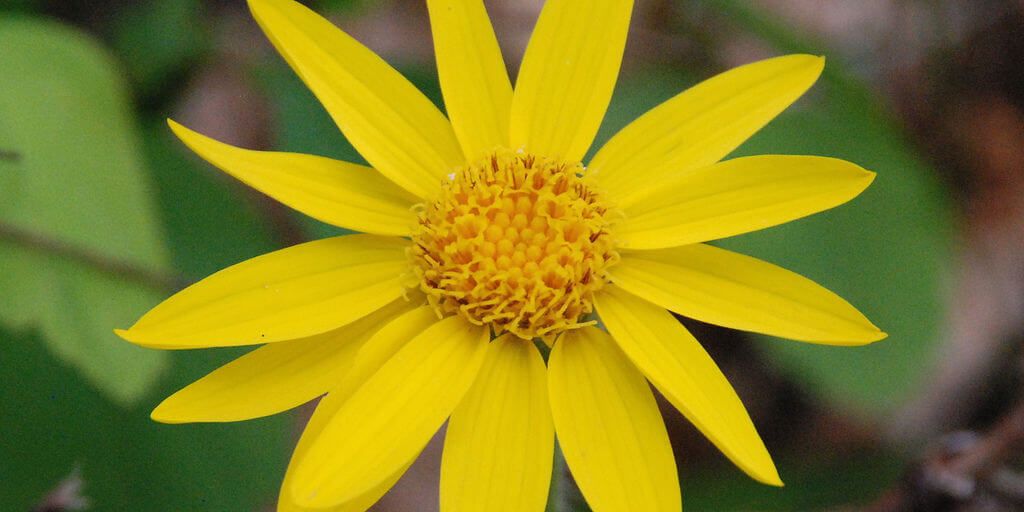Arnica, (Arnica montana), grows in the forests and mountain pastures of central Europe and Russia, the Pyrenees, North America and Canada. The dried flower heads and rhizome roots are used medicinally and were first used by Swiss mountaineers to help prevent sore and aching limbs.
Active Ingredients in Arnica
Arnica Flowers
The bright yellow flowers of the Arnica plant are the most commonly used part. They contain active compounds like sesquiterpene lactones (e.g., helenalin), flavonoids and essential oils, which have anti-inflammatory, analgesic and antimicrobial properties.
Topical Applications: Arnica flower extracts are used in creams, ointments, gels and tinctures. These can be applied to the skin to treat; bruises, sprains, muscle pain, insect bites and inflammation.
Avoid Taking Internally: Arnica contains the substance helenalin, which is toxic in large amounts.
Arnica Roots and Rhizomes
These are less commonly used but also contain medicinal compounds. They can be processed into tinctures and extracts. The roots contain derivatives of Thymol, which is one of a group of naturally occurring compounds with strong antimicrobial action (aslo known as biocides). Thymol can even reduce bacterial resistance to common antibiotics such as penicillin.
Topical Use: Similar to the flowers, root and rhizome extracts are used in topical preparations for their anti-inflammatory and pain-relieving effects.
Arnica Health Benefits
Although Arnica may be an historical remedy for healing bruises, modern science has showed that the role it plays doesn’t just stop with reducing bruises. Increasing evidence suggests that it also may help the body recover from surgery, toothache and even childbirth. Research on dental patients showed that Arnica helped to control pain and bleeding after treatment.
Arnica can also be used on unbroken skin to alleviate sprains, muscle pains and dislocations, Arnica is said to be helpful when applied to unbroken chilblains. Applied promptly, it helps prevent the formation of bruises by stopping the capillaries from bleeding.
How Does Arnica Work
Arnica works by stimulating the activity of white blood cells which process congested blood, and by dispersing trapped fluids from joints and muscles as well as from bumped and bruised tissue.
Arnica also has anti-inflammatory and anti-bacterial qualities and it is these qualities that help to reduce pain and swelling, as well as improving wound healing.
Arnica Research Studies
Recent trials involving a team of rugby players and a group of mothers with young children compared the efficacy of different bruising treatments.
A variety of bruising treatments were used including anti-oxidant injections, sports compresses, painkillers and vitamin K, which is thought to speed up healing, as well as Arnica cream and pillules (homeopathy so very low dose).
In virtually all cases, Arnica was the favoured option, both cream and pillules.
How to Take Arnica
Arnica with Vitamin C
Arnica is often taken alongside Vitamin C and bioflavonoids, as both of these further boost the capillaries to withstand knocks.
Arnica Cream (Topical Formulation):
Localized Action: Arnica creams are applied topically to the skin, providing a localized effect. The cream is absorbed through the skin, targeting specific areas of concern.
Direct Application: Arnica creams are commonly used for conditions such as bruises, sprains, and muscle aches. The direct application allows for targeted relief at the site of application.
Arnica Tincture
Adding 15ml of Arnica tincture to a hot water foot bath is said to provide relief for tender feet. Arnica tincture applied to the scalp is said to stimulate hair growth.
Arnica in Homeopathy
The popular Arnica pillules that are widely sold, are homeopathic products rather than herbal products, so they provide a very low dose of Arnica per pillule.
| Need Personal Advice? Book a private consultation with me, Cath Davis (Master Herbalist) and get expert advice and a plan that works for your body – no guesswork needed. |
Always take care when taking herbs and Read Our Disclaimer.
Arnica Herb Notes / Side Effects
External Use Only: Arnica is seldom used internally because of its irritant effect on the stomach. Arnica should not be ingested as it can be toxic. Internal use is generally limited to highly diluted homeopathic preparations.
Allergic Reactions: Some individuals may experience allergic reactions or skin irritation. A patch test is recommended before extensive use.
Avoid Broken Skin: Do not apply arnica to open wounds or broken skin as it can cause irritation.
Keep Exploring…
Curious what other natural remedies can do? Explore the full A–Z of our Natural Healing articles.


Leave a Reply